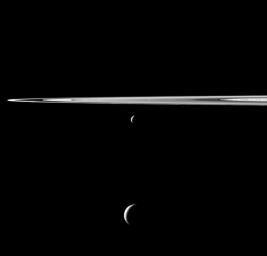
|
Pendent Pair
- Click the image above for a larger view
- Full-Res JPEG (1018 x 977) (18.3 kB)
- Full-Res TIFF (1018 x 977) (995.8 kB)
Caption:
A pair of Saturn's moons appears as if hung below the planet's rings in this Cassini spacecraft view.
Enceladus (313 miles, or 504 kilometers across) appears just below the rings here, near the center of the image. Tethys (660 miles, or 1,062 kilometers across) is near the bottom center of the image. Tethys is closer to Cassini than is Enceladus.
This view looks toward the northern, sunlit side of the rings from just above the ringplane.
The image was taken in visible light with the Cassini spacecraft wide-angle camera on Sept. 13, 2011. The view was obtained at a distance of approximately 169,000 miles (272,000 kilometers) from Enceladus and at a Sun-Enceladus-spacecraft, or phase, angle of 135 degrees. The view was obtained at a distance of approximately 129,000 miles (208,000 kilometers) from Tethys and at a Sun-Tethys-spacecraft, or phase, angle of 135 degrees. Image scale is 10 miles (16 kilometers) per pixel on Enceladus and 7 miles (12 kilometers) per pixel on Tethys.
Background Info:
The Cassini-Huygens mission is a cooperative project of NASA, the European Space Agency and the Italian Space Agency. The Jet Propulsion Laboratory, a division of the California Institute of Technology in Pasadena, manages the mission for NASA's Science Mission Directorate, Washington, D.C. The Cassini orbiter and its two onboard cameras were designed, developed and assembled at JPL. The imaging operations center is based at the Space Science Institute in Boulder, Colo.
For more information about the Cassini-Huygens mission visit http://saturn.jpl.nasa.gov . The Cassini imaging team homepage is at http://ciclops.org .
Cataloging Keywords:
| Name | Value | Additional Values |
|---|---|---|
| Target | Saturn Rings | Enceladus, Tethys |
| System | Saturn | |
| Target Type | Ring | Satellite |
| Mission | Cassini-Huygens | |
| Instrument Host | Cassini Orbiter | |
| Host Type | Orbiter | |
| Instrument | Imaging Science Subsystem (ISS) | |
| Detector | Wide Angle Camera | |
| Extra Keywords | Grayscale, Visual | |
| Acquisition Date | ||
| Release Date | 2011-10-10 | |
| Date in Caption | ||
| Image Credit | NASA/JPL-Caltech/Space Science Institute | |
| Source | photojournal.jpl.nasa.gov/catalog/PIA14577 | |
| Identifier | PIA14577 | |
